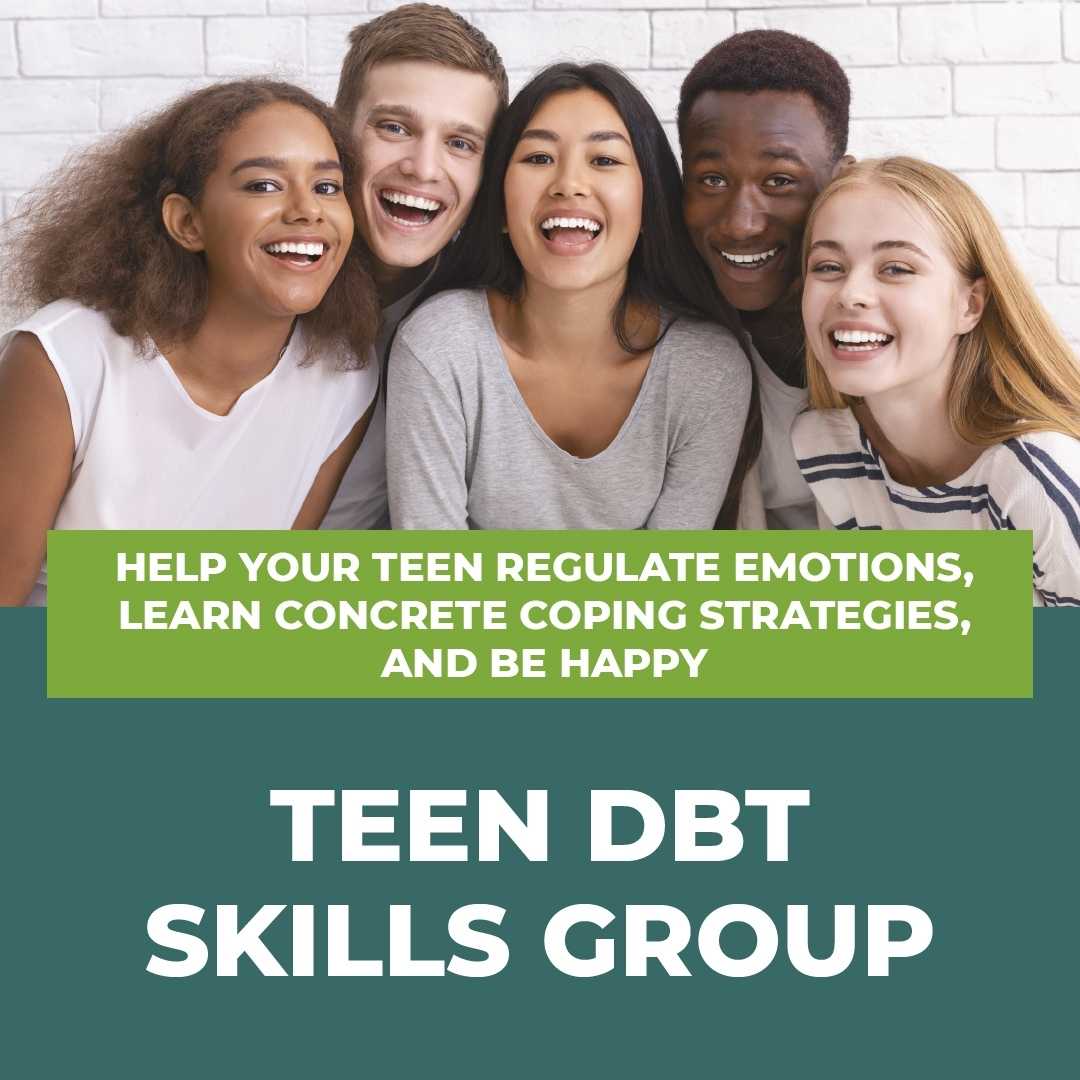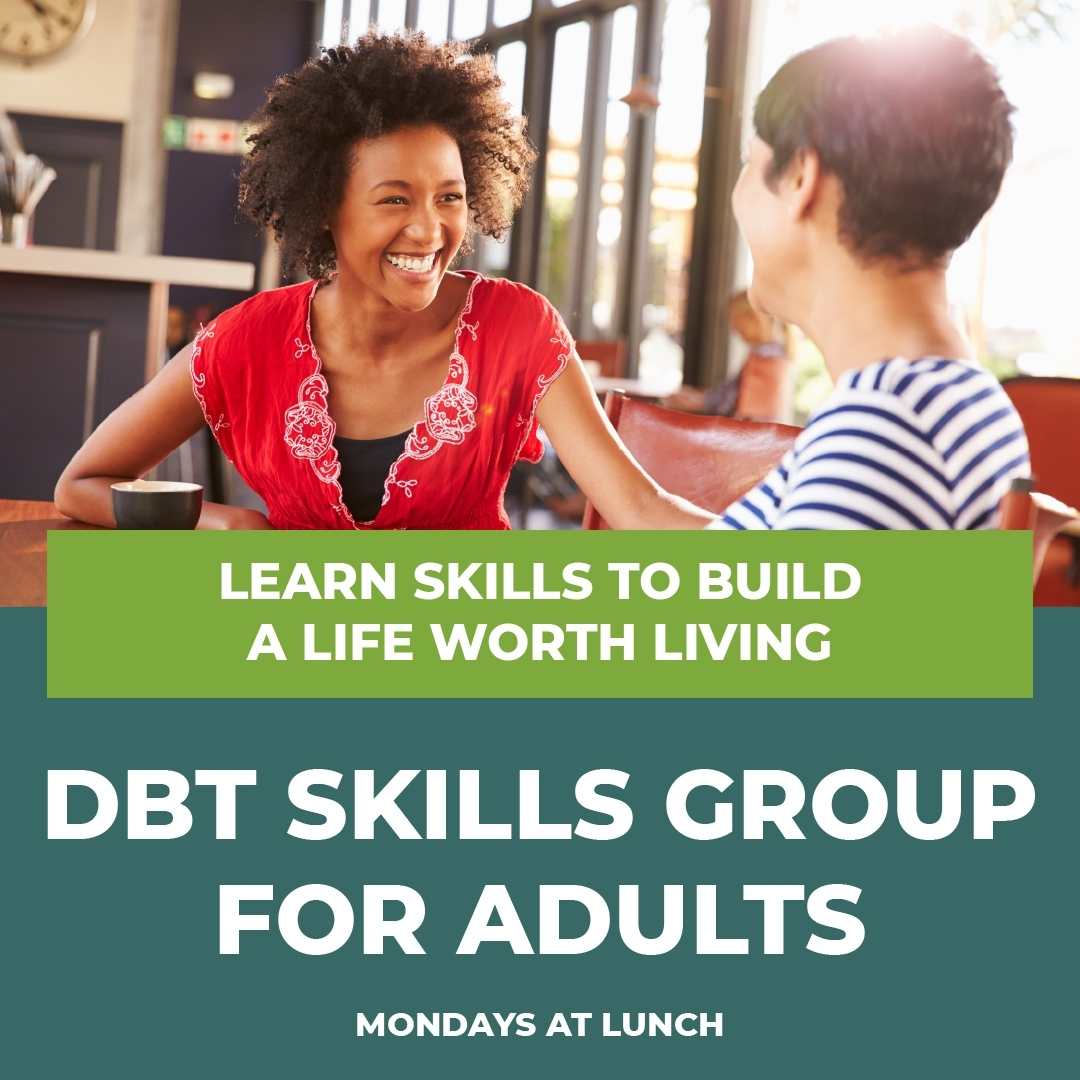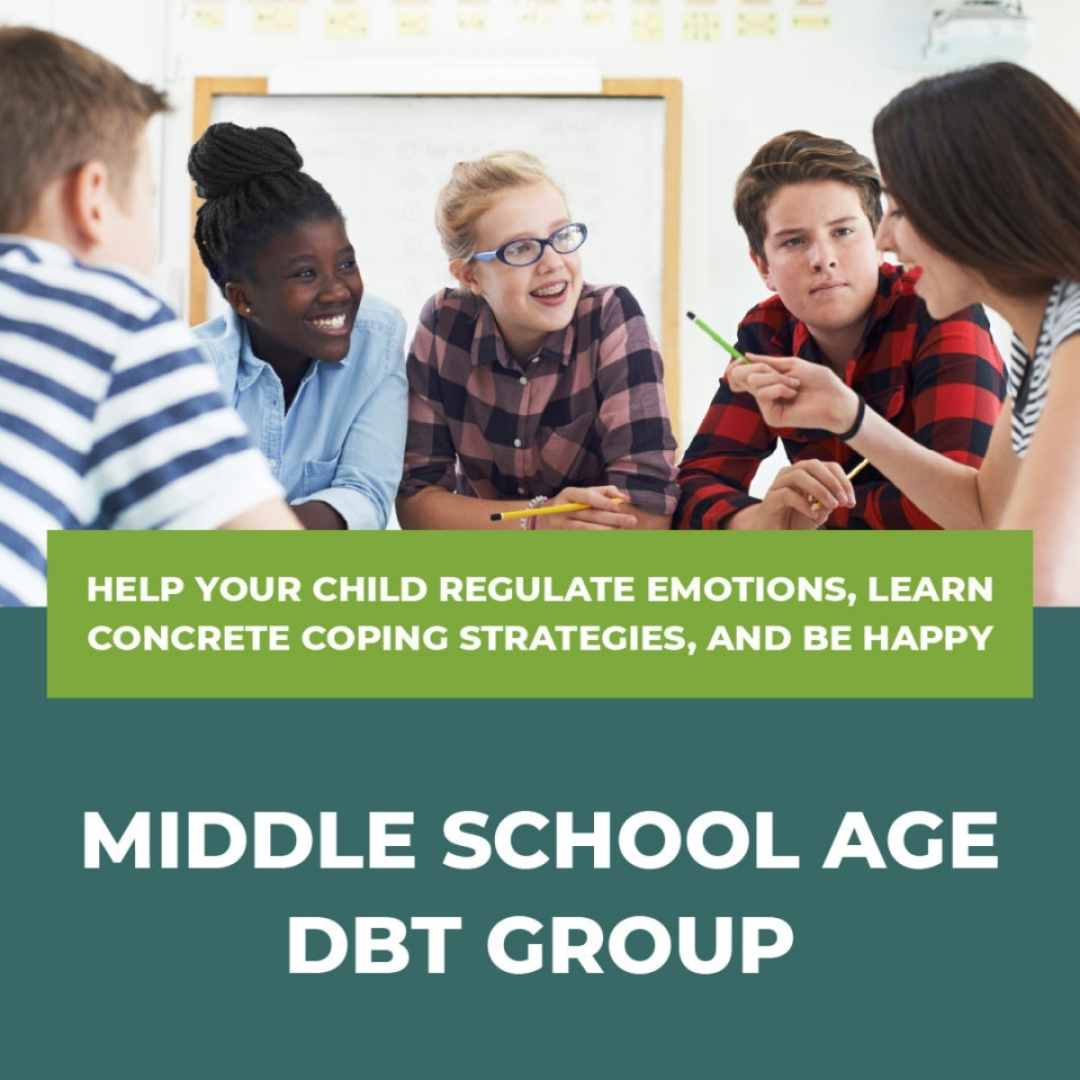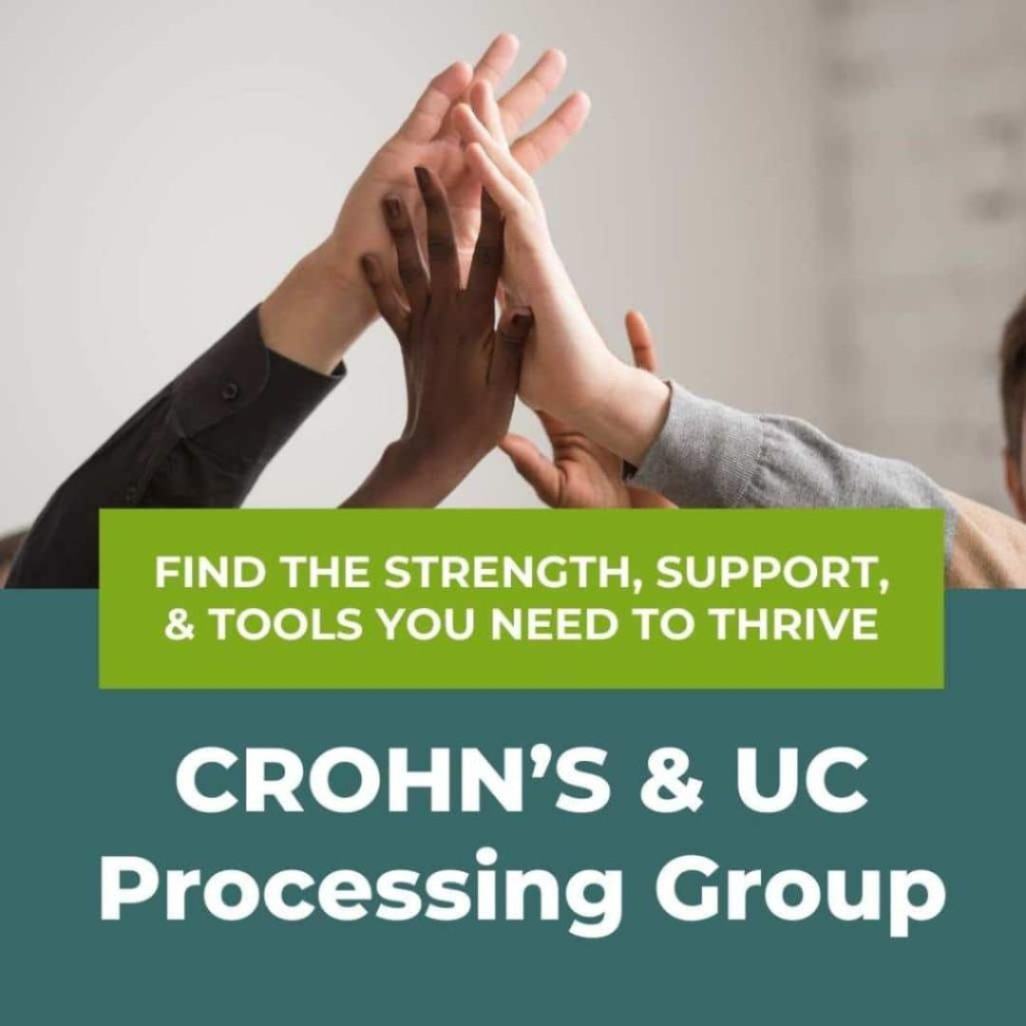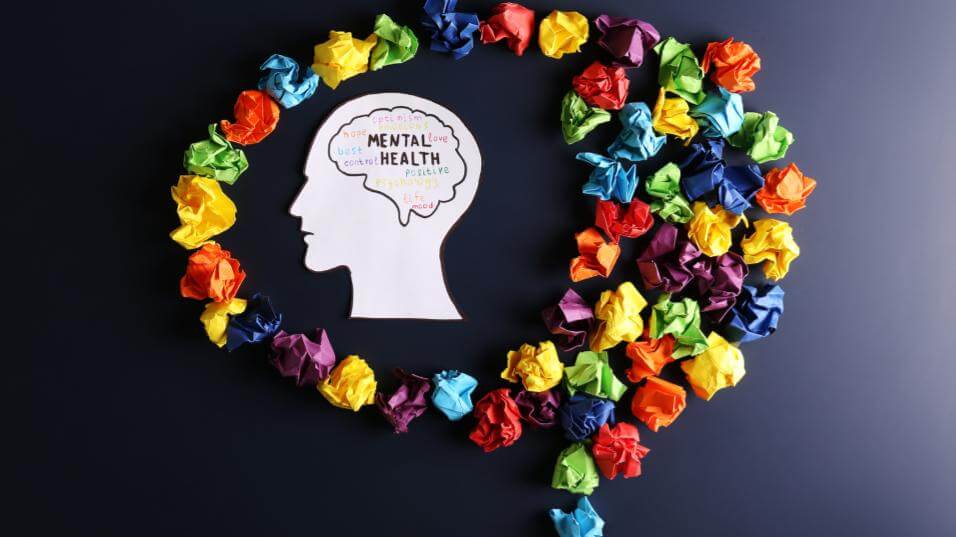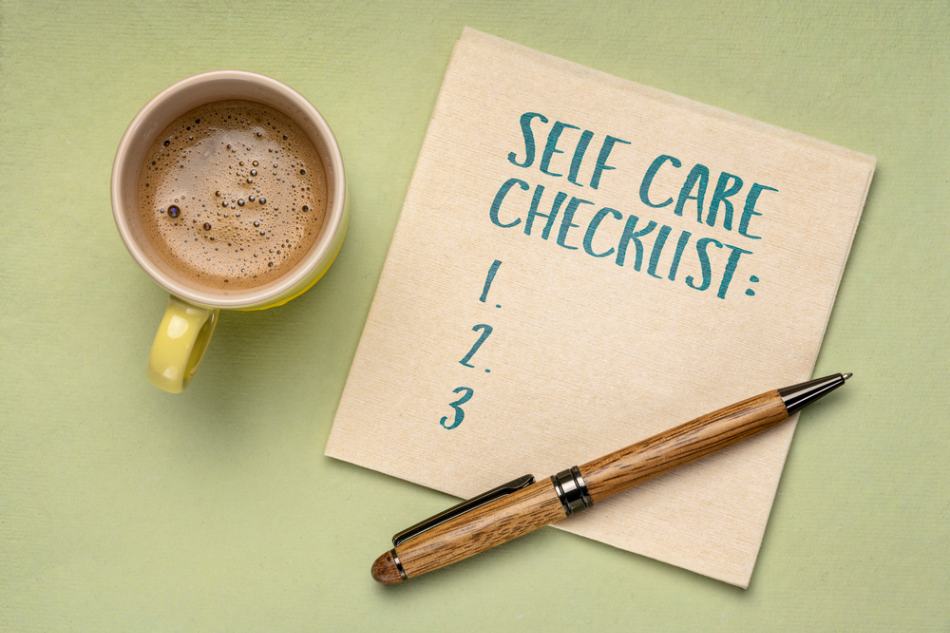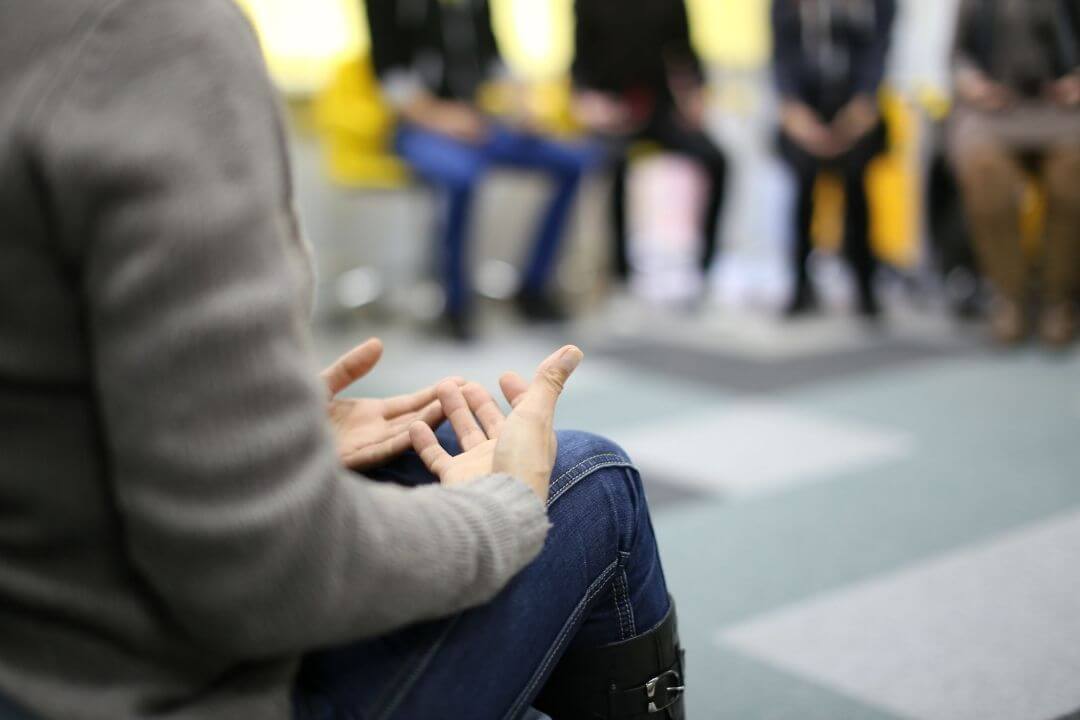May 11, 2023
Webinar: How DBT Mindfulness Skills Can Help You Manage Emotions & Stress
Written by Rachel Eddins
Posted in Emotional & Mental Health, Stress Management, Webinars and with tags: DBT, mindfulness
Do you need help managing your emotions and stress? In this webinar, learn how DBT mindfulness skills can help you manage both.
We will go through a deep dive into understanding mindfulness skills through a Dialectical Behavioral Therapy (DBT) framework. Learn what DBT mindfulness skills have to offer, why they are effective, and when to use them to manage difficult emotions.
This webinar is presented by Jennifer Castro, LMSW. Jennifer is under the supervision of Marcie Dinkin, LCSW-S.
Watch a replay of the presentation here.
Learn more about DBT – Dialectical Behavior Therapy and DBT Mindfulness Exercises.
Here is a transcript of the webinar:
Hello, everyone. Thank you for joining us today. My name is Jennifer Castro, and I am a counselor at Eddins Counseling. I’m so grateful and thankful to each of you for joining us this evening for our May Wellness webinar.
Today we will be talking about a DBT skill which is referred to as mindfulness. I’m sure many people have probably heard about this as a buzzword going around on social media, and I love that people are talking about it.
I am going to go over why this DBT skill is so important. And so what I mean by that is that I may take a little bit to get to the actual skill that we’re going to be working on. But I really want to just give you the meat of why this is helpful and all.
Every month, Eddins hosts these monthly webinars. Just make sure you’re on the lookout for next time around.
A little bit of background about me:
Again, my name is Jennifer Castro.
I am a licensed master of social work, and I currently host or facilitate the Middle School DBT group here at Eddins. I’m a therapist in our Montrose location.
In case anybody has middle schoolers who you think could benefit from that, we often talk about all the DBT skills. So mindfulness is just one of them.

DBT Mindfulness Skills
Every moment is a fresh beginning.
Mindfulness skills teach us to increase non-judgmental awareness of our present-moment experiences. By slowing down to experience the present moment, we are able to reduce our stress, pain, and suffering and increase our capacity for pleasure, and joy.
- Mindfulness is intentionally being aware of your present moment: thoughts, feelings, and physical sensations.
- Without judging or rejecting the moment: attachment or avoidance.
- Without attachment to the moment: past experiences or future outcomes.
- Mindfulness can be practiced at any time, anywhere, and any place.
DBT stands for dialectical behavior therapy. Dialectical means that more than one thing can be true at a time.
So when we go in and do a deep dive on mindfulness today, we’ll talk about how we can hold space for mindfulness in our lives, even when life can be chaotic and stressful, difficult to manage sometimes, if you will.
I think before we begin, I am going to do a mindfulness skill now.
One of the things that I will share with you is that it’s going to feel a little weird and maybe a little bit uncomfortable at first.
Mindfulness takes a lot of practice to be comfortable with.
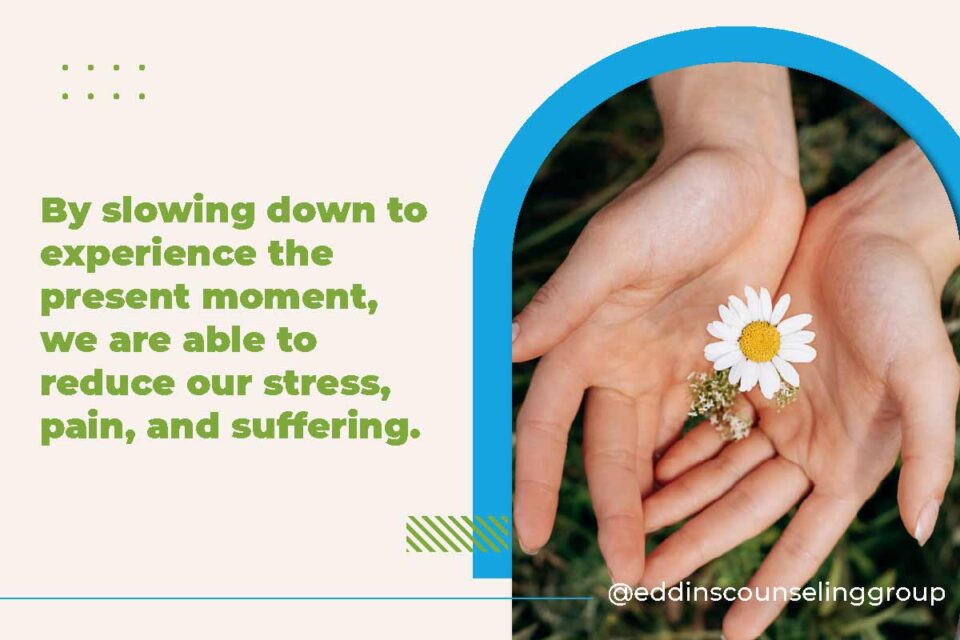
It is something that often we neglect in our very busy hustle and bustle culture. Oftentimes, as many of you know, we are ripping, and running throughout the day.
Maybe you have children, a very demanding job, multiple jobs, or maybe you just find life to be sometimes a little bit stressful as it sometimes is.
So in order to get us started, I am going to do a grounding technique, and it is something that we do to get back into our five senses.
If you remember, our five senses are hearing, seeing, tasting, touching, and the sense of smell.
I would like everyone to scan their surroundings, and I’m going to take a little bit of time. It’s going to also slow me down a bit. Again, it might seem a little fluffy or it might seem a little bit like “Why are we doing this at first?” And that’s a normal response.
That’s a natural normal response that many people have. I’d like to hold space, and I’d like for you guys to hold space for those feelings without any judgment.
Anytime you feel your mind wandering away, just gently bring it back and remind yourself that it’s okay to be in this space and we’ll do it together.
Do you have a couple of things that you can smell nearby, especially if they’re pleasant, like candles or flowers or whatever you might have nearby? And also if you could grab something that you can taste.
If you don’t have any of those things nearby, that’s also okay. You don’t necessarily need them because you can do and practice mindfulness anywhere at any time and at any place.
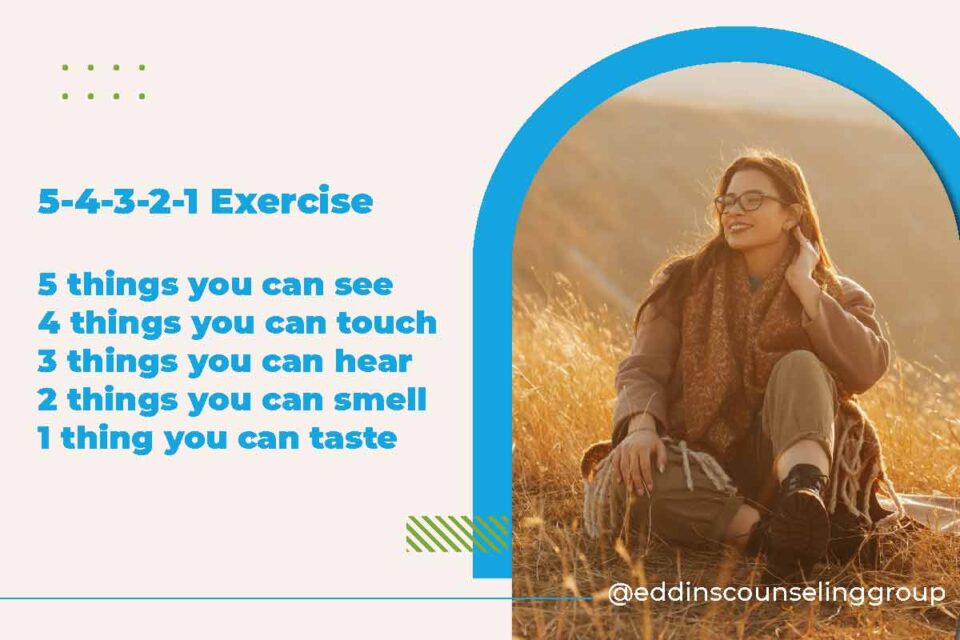
5-4-3-2-1 Exercise
This exercise is called 5-4-3-2-1, and it is connecting with your five senses. First things first, we are going to stop, put our feet on the floor and reconnect with our bodies.
We’re going to just be mindful of the space that we are in at this moment. I would like to ask each of you to take a look around and observe where you are. If you’re in your bedroom or you’re in your living room or wherever you are, I just want you to take a look around and just notice where you are and what’s around you.
Then I would like for you to select five items in the room that we can see, and I want you to think about their color, their texture, their shapes, and what you notice about them.

Perhaps you have your favorite plant nearby. I want you to think about what that plant might elicit for you.
- Maybe you might see a painting that you love, some artwork from your children.
- Maybe you see a photo of someone that you love and they are near and dear to your heart.
- Maybe you see something that you’ve been working really hard on.
- Maybe you see your reflection, and if you do, smile at yourself.
But really hold space and really take it in. Take it in for each item. I’m even looking around my space right now.
Next, we’ll be moving on to four things you can touch. When you are touching them, I want you to really touch them. For example, I have this blanket here and I’m going to feel what it feels like.
The texture:
- Is it fluffy?
- Is it soft?
- Or, is it rough?
- Is it cold?
- Is it hot?
Think about what it’s doing for your senses, especially for your sense of touch.

Some people will say: “Oh, I don’t have anything nearby.”, so they’ll touch their hair or maybe their leg. And if you touch a part of your body, remember to say thank you to it.
The whole point of the 5-4-3-2-1 exercise is to really connect to your surroundings, connect and be present with your body, and slow down a bit.
Next, we will be thinking about three things we can hear. For this one, it requires being still and really listening.
Sometimes you might hear things automatically because maybe you’re in a noisy environment and that would be lovely.
Sometimes if you’re in a quiet environment, you have to be very, very, very still because you might hear the air conditioner, cars outside, or trains passing by. We’re just sending gratitude to this moment of being able to hear.
The next thing we have is connecting to our sense of smell, two things we can smell. We’re thinking about things that elicit joy, but it doesn’t have to be. It can also be whatever is nearby. Some people love the smell of cooking or their favorite tea.
As you’re smelling it, I really want you to take it in and just give gratitude for your sense of smell and just be able to say “thank you” to that. And again, if you have any judgmental thoughts about it, it’s okay. Let it pass and stay present.

Lastly, we have taste. Focus on one thing we can taste. So if you can taste whatever it is that you have near you.
And for some, you may not have much, and that’s okay. Even if you have water nearby, you can use that.
But if you have like a chocolate or a mint or maybe something that you enjoy, that would be lovely.
As we do that, we’re also showing gratitude to our sense of taste.
I want you to savor in that moment for just a bit because life can be super busy and we have a ton of other responsibilities. But at this moment, we’re just sitting here and being present.
Now you are done. I would love for you to do a couple of deep breaths.

Just take a deep breath in and hold it and let it go. When you let it go, I want you to just empty your belly and really just think of releasing the worries from the day away.
We’ll do it again a couple more times.
Deep breath in, hold, and release.
Last one.
Deep breath in, hold, and release.
I hope that some of you were able to do it the whole way through, and I hope that it was helpful for you. I will be honest that a lot of times that I did it, it really didn’t feel very good. But that is something we’ll be talking about today.
These skills are really like muscles that you need to build over time. And so they definitely take a lot of practice.
Now when I do that, it really is helpful. But there was a time when it didn’t feel like that for sure. But I do hope that some of you felt that it was helpful.
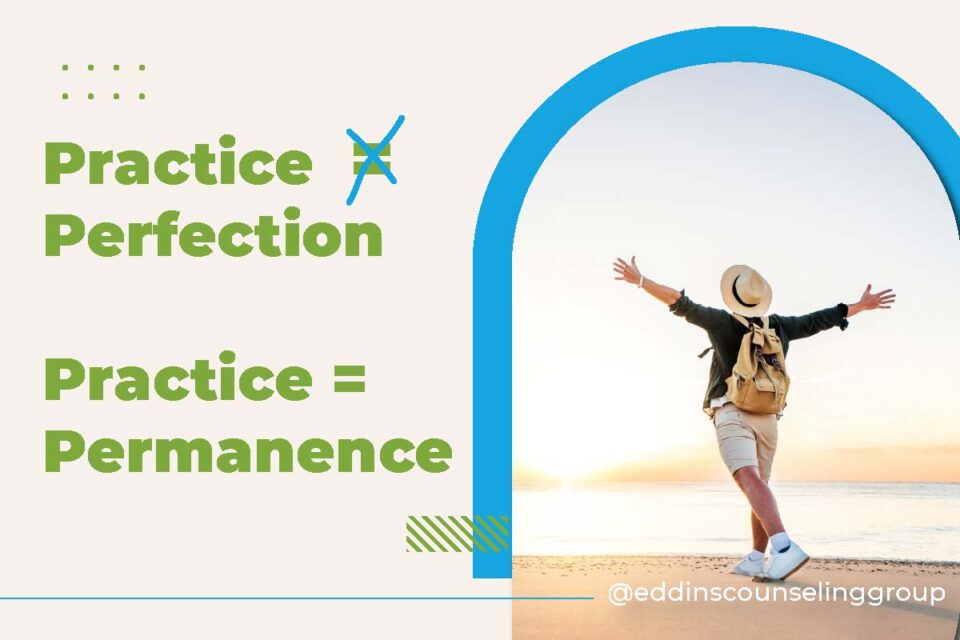
When we’re thinking about mindfulness skills, we’re really taking into consideration what they teach us. Essentially what they’re used for is to not judge yourself or not judge the thoughts that come up.
So we’re really practicing nonjudgmental awareness of our present-moment experiences.
When we’re able to slow down and experience the present moment, we’re able to reduce our stress, pain, and suffering, and increase our capacity for pleasure and joy.
There really is something to be said for stopping and smelling the roses.
But there are lots of studies that have shown when we’re able to use these skills and really put them into practice on a daily basis and do it over and over again, it’s really interesting how it really can release tension in the body, how it can decrease pain for people who suffer from chronic pain, and really just help in stress reduction.
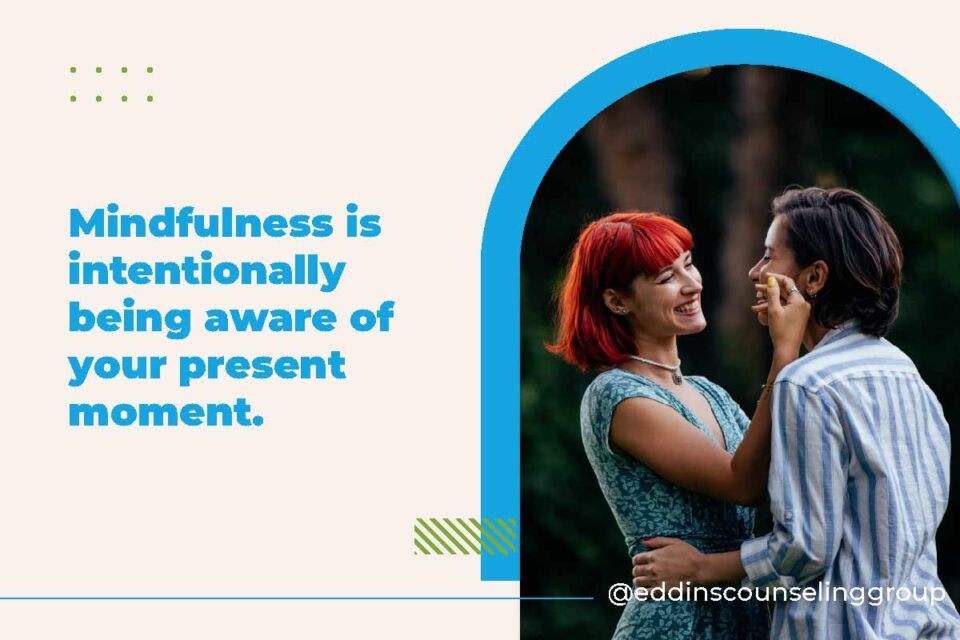
Mindfulness is intentionally being aware of your present moment. What that means is being aware of the thoughts that come up, being aware of the feelings, and being aware of the physical sensations.
When I say physical sensations, I really mean just do a body scan when you do this type of exercise or all the other exercises.
- Some people might hold tension in their jaw.
- Some might hold it in their shoulders, or maybe their neck.
- Some might have chronic pain in the lower back or maybe your knees or something like that.
And so when you’re doing a body scan, one of the best things you can do for yourself is notice where you’re holding your tension.
When you do that, then you can draw awareness to it. And awareness is the first step in being able to make it subside.
Pay attention to your physical sensations and also think about the thoughts and feelings that pop up.
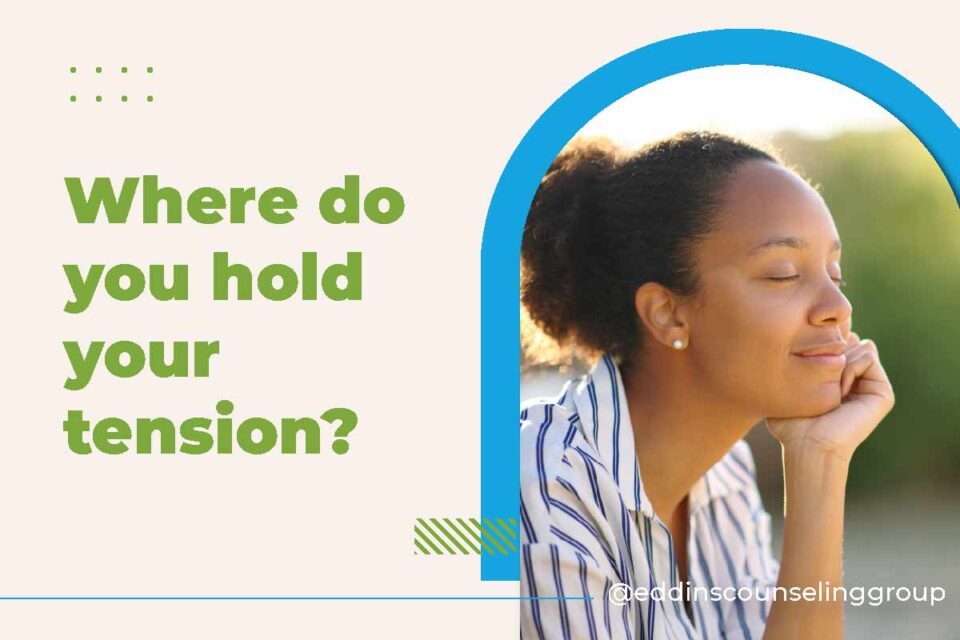
Let’s say you’re going throughout your day, it’s busy and you’re multitasking and things. Some thoughts may just be very practical.
They might just be like: “I still have X, Y, and Z to do.” or “I still have to pick up the kids and I have to buy groceries”.
Or you might be a student and say: “Oh, I have four assignments due and I’m not sure how to get them done”.
And so what I’ve often seen or what I’ve often heard, especially in talking to several different populations of people is “I don’t have the time”.
We can often be, especially if you live in a big city like Houston, it can be really difficult to say: “How can I slow down in such a busy world?”
And yet when we’re able to slow down, that is literally when we’re able to probably do some of our best work. So it really makes the most sense to be able to. And yet it can be pretty challenging.
We have five core feelings, and that is fear, joy, anger, guilt, and sadness.
Within those feelings, there are lots of other things that will pop up. But when these things are with us, all we need to do is take notice of them.
Just don’t judge it. And also don’t reject the moment.
Sometimes we can plan ahead. We might be really planners and if we can detach ourselves from certain outcomes or if we can really just be present, don’t worry about the past, don’t worry about the future, just be present in this moment.
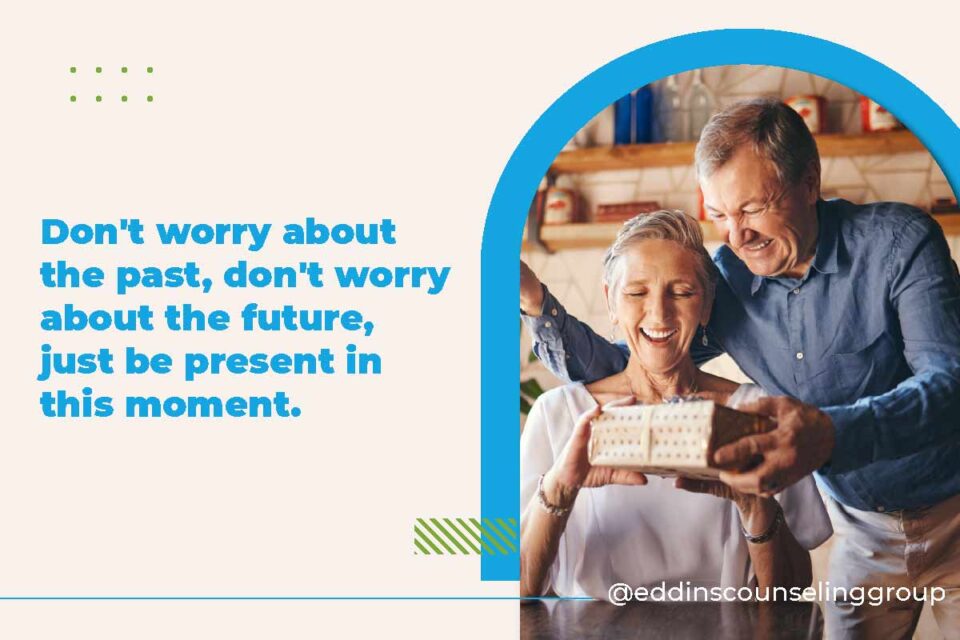
Mindfulness Practice
Get back in touch with your body and surroundings
- Meditation
- Focus on the mind
- Let go of the
- Centered Player
- Selected word or theme
- Interior silence
- Relationship with God, or Higher Power
- Mindfulness Movement
- Dance
- Music
- Yoga, Martial Arts
- Walking, biking, hiking with focus on body movement, or natural world around you
Mindfulness can be practiced anywhere or anytime.
What does this look like in real life? What does it look like on a day-to-day basis?
I would say what it looks like is because it can be practiced anywhere and at any time and in any place. It can literally be anything. You can be in your car.
It could just be staying centered or being grounded in your moment, taking deep breaths, things like that.
In addition, there are also mindfulness movements that we can do. Some of them would be things that we are probably all super familiar with, at least in terms of hearing about them.
One of them is my favorite- dance. If we’re dancing, we are able to be connected to our bodies. And oftentimes we’re able to slow down time. Just forget about everything else at that moment.

Another would be listening to music, yoga, martial arts, walking, and biking.
I think when you’re doing anything in nature, you’re connecting. So it could be gardening, it could be swimming. It could be any type of thing that is getting you to move and slow down because all of those things take practice.
So in some ways, you have to slow down for that.
Additionally, we have things like meditation. With all of these things, the goal is focusing. Focus on one thing at a time. Focus on just the activity you’re doing. And focus your mind.
Let go of outcomes. Let go of the need to control things, which can be something that we all tend to want to do.
We want to control what’s next. I think that is part of the human experience and I definitely want to normalize that for everyone.
Centered Player
Also, I love that part of this is just centered prayer. I don’t know how many people practice prayer on a daily basis or on a regular basis, but I think many people might have grown up in places and spaces where there was prayer.
But this could also just be interior silence.
So if you’re just sitting without background noise from the television or without distractions from your phone, we could also consider that as a mindfulness practice.
I would even argue that, especially in today’s day and age, where we’re all super connected to our devices, those types of quiet time are really beneficial to regulating our nervous system and just helping our brain decompress and whatnot. So there’s that piece.
If you are engaging in a centered prayer, what that means is selecting a word or maybe a theme. For some people that can look like a specific request that they may be bringing to the table or something like that.
If you are able to select a word or theme and you’re able to sit with that for a little bit, it really does help to bring your mind back when it starts to wander because that is super common.
It’s really common for us to just wander off because that’s just how it is sometimes.
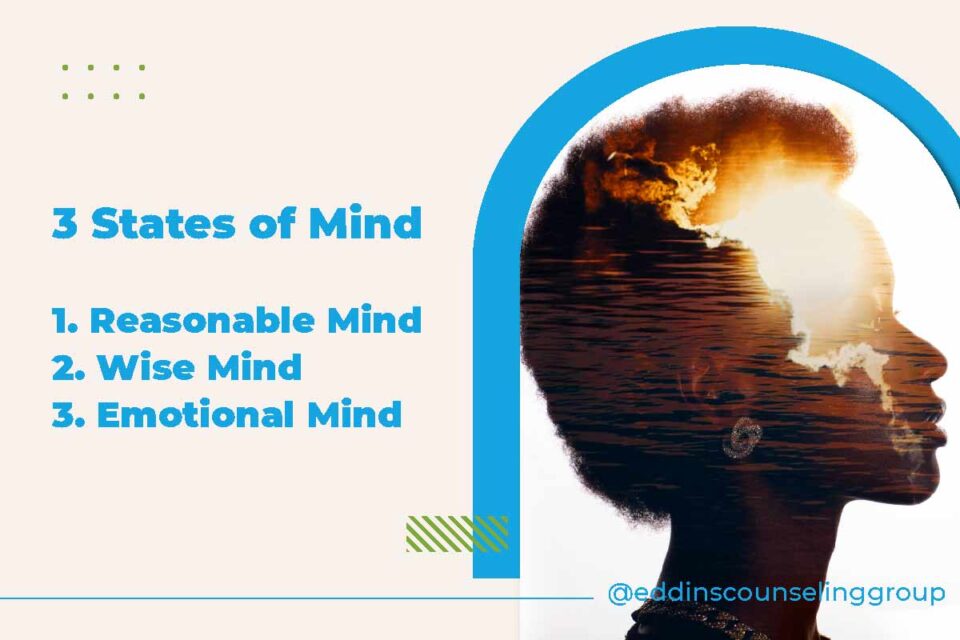
Three States of Mind
Accessing Our Inner Wisdom
If we were to start practicing mindfulness on a very regular basis, there are certain types of emotional states of mind that we would encounter.
Reasonable Mind
- Logic based
- Can be attached to outcomes
- Based off of thoughts, and reason.
Wise Mind
- The inherent wisdom within each person
- Harmony
- Balance
Emotional Mind
- Often impulsive
- Controlled by feelings and urges
The first that we have on the table is what we call a reasonable mind. A wise mind is what we strive for.
It is essentially very much like intuition. It really helps us to stay centered and balanced and brings harmony. It’s the inherent wisdom that we each have. And then we have an emotional mind.
A reasonable mind is very logic based. It is very attached to outcomes and based on thoughts and reason. It’s that little voice inside your head that when you are working through a problem, it’s offering solutions.
It’s the one that says “We can’t do that”.
Like, for example, the Yeti cartoon. It’s a cartoon with a brain and then a heart. And they have super cute little skits in them. A reasonable buying would be the brain and your emotional mind would be the heart. It’s very heart-centered.
It can be impulsive and controlled by your feelings and urges.
It doesn’t necessarily mean that that’s a bad thing, but it’s more like when you’re getting into a little spat with your spouse or your partner and your reasonable mind is like: “You shouldn’t say that”.
But then your emotional mind is like: “No, we’re going for it”. That’s what that’s like.
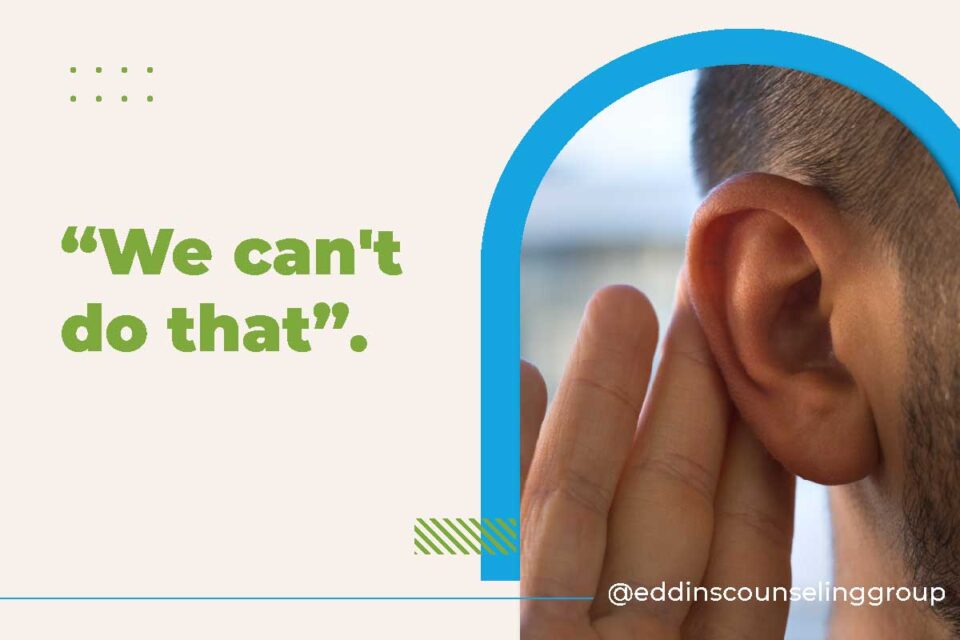
When we are able to hold space for both when we’re able to slow down, and when we’re able to bring reason and logic with our emotions, then we meet in the middle and we find our wise mind.
I love a wise mind because when I think that I’m working in my wise mind, I think that I’m walking my middle path. Middle Path is another skill that we teach in DBT. It’s really all about what I mentioned earlier that two things can be true at once.
We hold space for all of those pieces of it with no judgment and just finding within us and connecting back to that piece of us what the wise’s choice would be for ourselves.
What is the healthiest way I can react or behave or show up in this situation? The thing about wise mine is that you really have to tune into it.
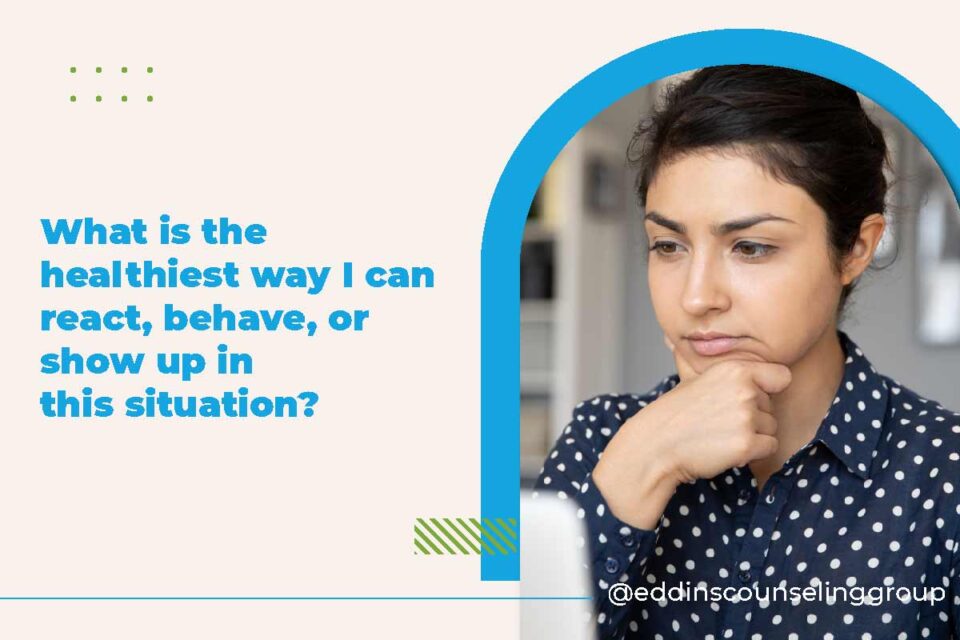
And I would agree with that because I often think that I have a strong inner voice where I can sometimes just have that deep-seated knowing.
It’s also true that I could very easily ignore it because my logical brain is: “No”, but that doesn’t make sense, even though intuitively I might know or my wise mind might know.
I don’t know how many people can resonate with this, but way back in the day, we used to have radios that you had to tune. You had to turn the dial to find the right radio station. And I would say finding your wise mind can often be like that.
Once you find it, you just know that’s it. That’s the station.
But sometimes you can get some static and sometimes you can just lose track a little bit. It’s just helpful to recenter when that happens and try to, again, hold no judgment to yourself on that because that’s just super normal.
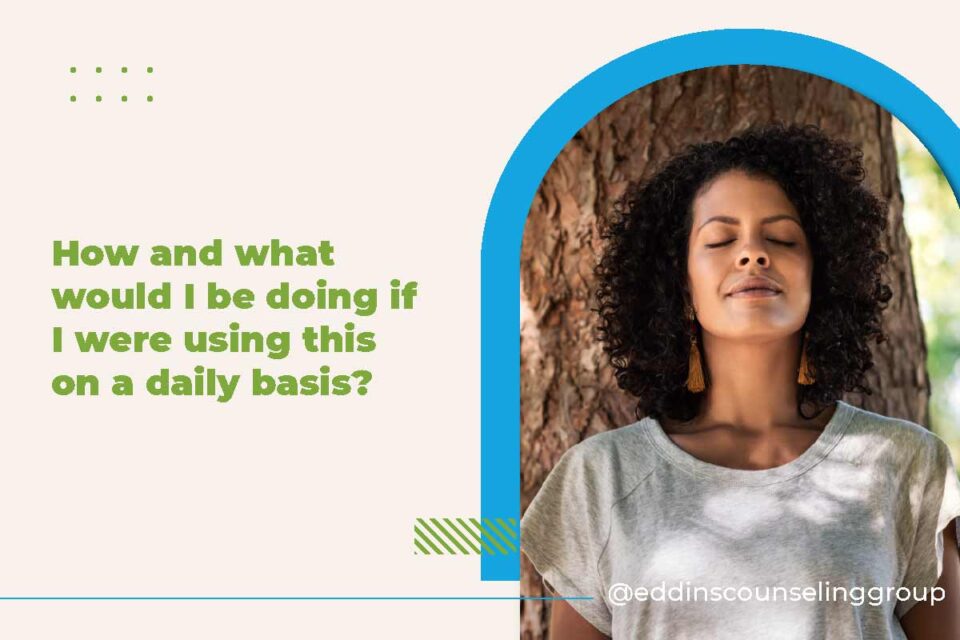
Mindfulness
“What”
- Observe
- Wordless watching: just notice the experience
- Observe with all 5 of your senses
- Don’t push away thoughts and feelings. Feel and acknowledge them even if painful
- Describe
- Label what you observe with words
- Stick to facts, and not thoughts or judgments
- Participate
- Fully throw yourself into the moment
“How”
- One-Mindfully
- The past is over and does not exist in the present
- The future has not yet come into existence
- The pain for the present moment is enough
- Act Effectively
- Stay focused and know the goal or objective
- Don’t judge
- Do what works for you
- Avoid multitasking
How and what would I even be doing if I were using this on a daily basis? What would this look like in real life?
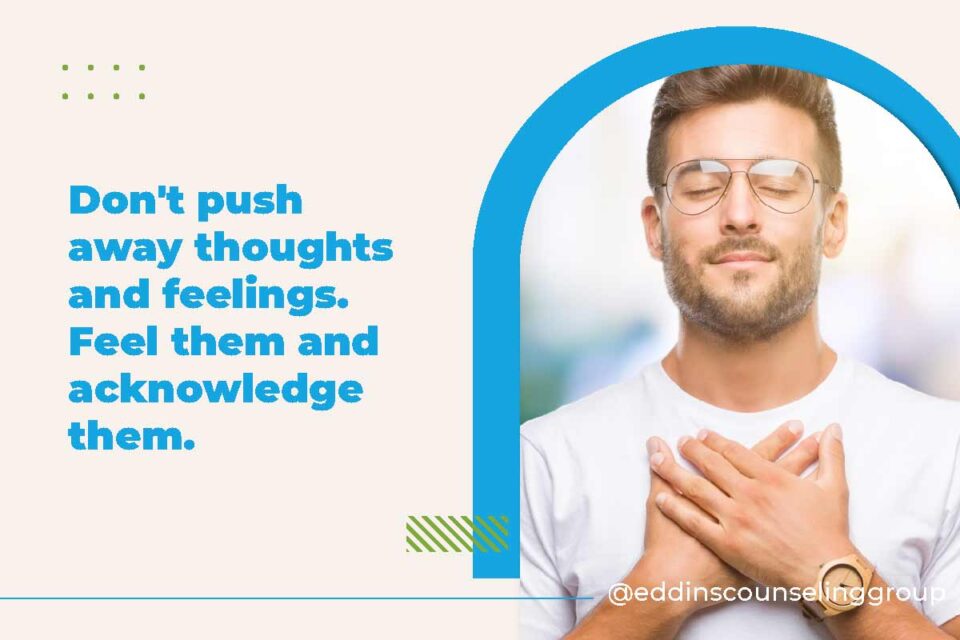
So let’s say you’re in the car in traffic and it’s just terrible. Being able to recenter ourselves, observe, and just notice the experience.
Again, with no judgment, sure, you may be upset, but again, you’re just wordless watching.
Use all five of your senses at that moment. Don’t push away thoughts and feelings. Feel them and acknowledge them.
That was a silly suggestion or maybe scenario if you will. But I especially mean this, if you are dealing with things at home, at work, or dealing with interpersonal relationship stuff.
Sometimes observing what might be happening can be painful, and it can be painful to acknowledge these things.
When we’re thinking about mindfulness, really all we’re thinking about is just finding our wise mind, finding our center, and slowing down a bit.
This can really help when especially in interpersonal relationships when there might be more of impulsive responses.
Also, you would describe and label them. You can what you observe with words. You can describe this to yourself out loud or internally. And you always want to stick with facts and so not thoughts or judgments. And so what does that mean?
Facts are just knowing the concrete evidence. Thoughts can be: “Well, my partner did X, Y, Z, and therefore it must mean this”. That’s just a thought. It’s not a fact. So you want to stick with facts in this case.
Then you would participate.
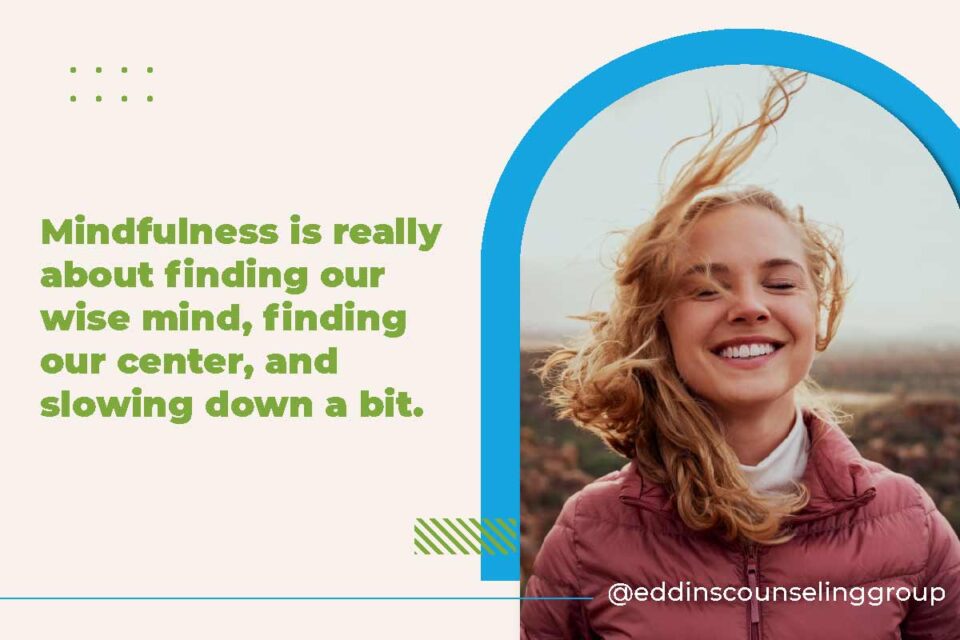
If you’re using mindfulness and you’re doing this in your day-to-day life, you want to fully throw yourself into that moment. At that moment, you’re in the zone.
You are giving your whole attention to being mindful. It can be the mindfulness thing. Maybe if you’re doing a movement exercise, that could be much easier to throw yourself into because it’s a physical thing, or maybe it’s meditation.
You’re physically being still. But if you’re out and about and you need to do some grounding at that moment, giving yourself the grace and the space to fully throw yourself into that moment would be important. So how do you do this?
One-mindfully just essentially means that part of being mindful means that the past is over and it no longer exists for us.
That can be sometimes hurtful. Sometimes things from our past may have been hurtful, but we can’t ruminate about it when we’re being mindful.
If you’re going through something really heavy, you can give yourself 10 minutes to be mindful, and then you can think about the past if you need.
But in these 10 minutes, you’re going to just fully throw yourself into the moment and let go of the past and not be attached to an outcome in the future.
I love that one of the things we say in DBT is that the pain for the present moment is enough. Because if you think about it, even if you’re having a wonderful day, there are probably still things going on, maybe not in your life, but around you that is enough pain.
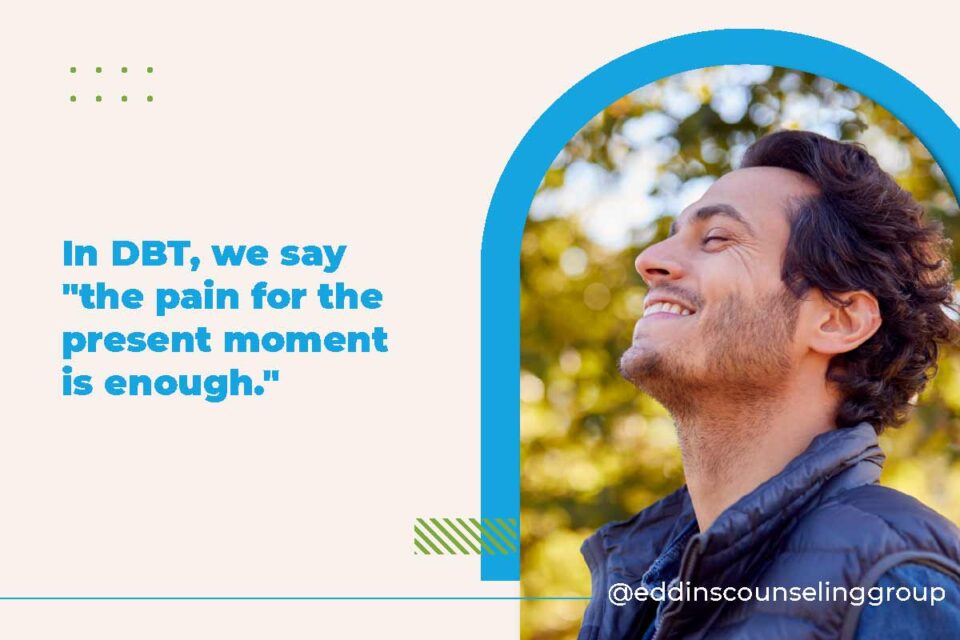
We don’t need to worry about the pain of the past or stress about the future. All we have to do is just recenter ourselves and be in the moment for the here and now.
Lastly, you want to act effectively.
Again, the common theme here is don’t judge yourself and do what works for you. So maybe the 5-4-3-2-1 doesn’t resonate with you, but maybe breathing does or maybe finding an app on your phone that has.
I know Calm is a big one that people use and it has guided meditations and things like that. Or maybe prayer is for you. So just do what works for you. I would also say to practice other things, even if they seem a little silly at first.
Lastly, avoid multitasking. So your time for mindfulness is not a time for you to worry about doing other things. It’s just that moment for you in that moment.
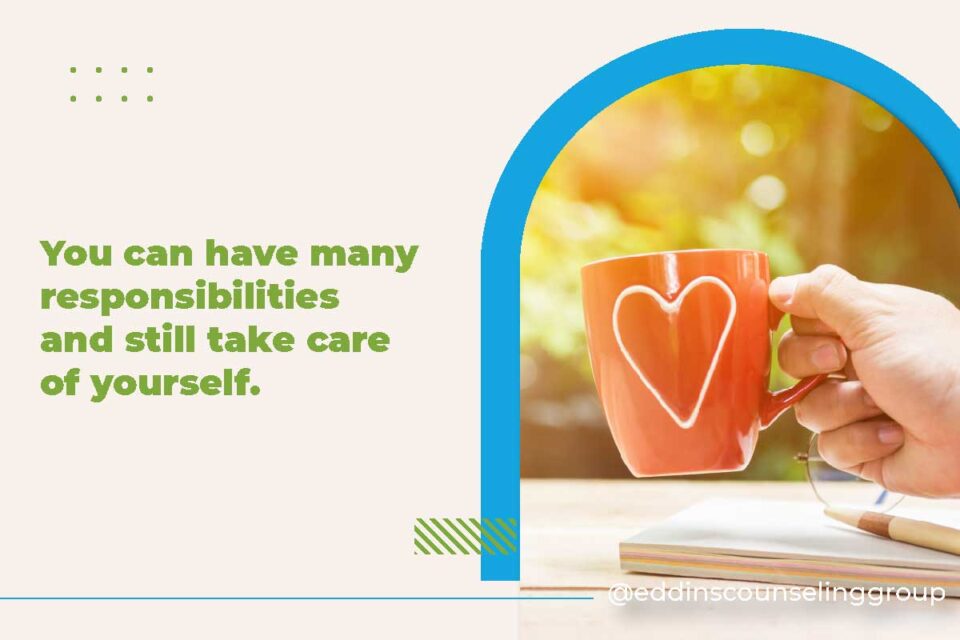
Find Your Centeredness
Join in the midst of it!
- Dialectical means two things can be true at once
- Stress usually occurs when we have many responsibilities to manage
- Often we neglect ourselves due to stress, thinking we can get more done if we keep going. The Middle Path helps us to understand that both can be true. You can have many responsibilities and still take care of yourself. Doing so creates more space for pleasure and joy.
Dialectical means that two things can be true at once.
We do often neglect ourselves due to stress, and we all have a ton of responsibilities. This whole part is just to remind yourself that you can find joy in the midst of it.
When you find your centeredness, and when you are able to connect to your wise mind, you can be stressed and take some time for yourself.
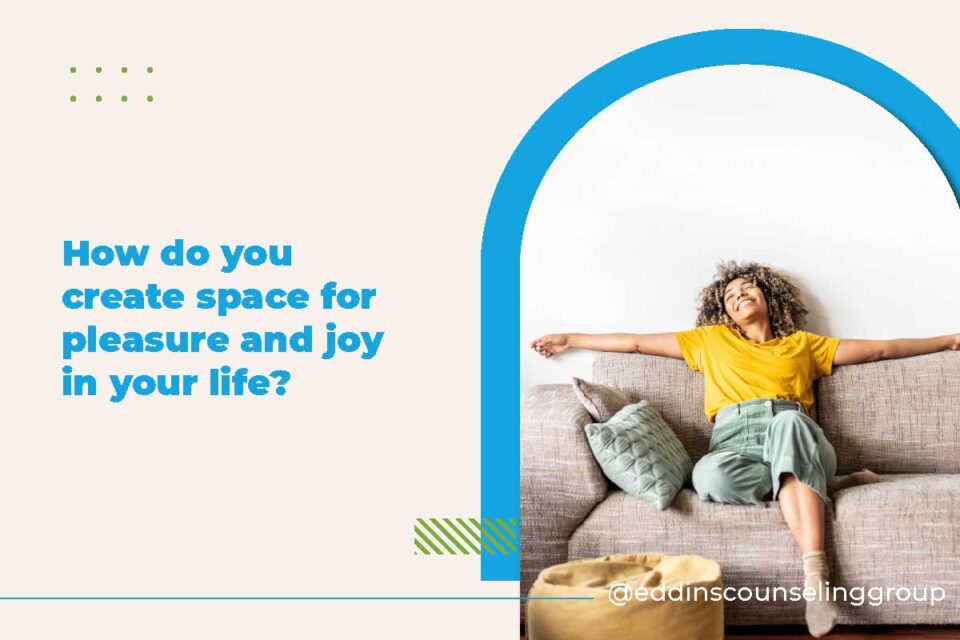
Does Mindfulness Sound Familiar?
The practice of mindfulness is timeless.
Mindfulness can be practiced for psychological, emotional, spiritual, or even medical reasons. The act of mindfulness originally stems from spiritual and contemplative practices across all types of cultures, regions, and times. This provides a sense of connection.
What I mean by that is that that inherent truth just makes it so that everyone can do it. Everyone across the span of time has been doing this.
When you see these buzzwords on social media or just online, really what you want to think is that you have already done that in some parts of your life. And so I want you to give yourself some applause in that way.
Grow in wisdom
The practice of mindfulness over time helps us to grow in wisdom and allows us to strengthen our ability to use our wise minds. Wisdom involves both the heart and the brain.
Experience freedom by letting go
When we let go of attachments and outcomes, we find the freedom to experience the present moment as is. In this, we are free to pivot, move, and change.
Increase love and compassion
By engaging in mindfulness, we allow space in our lives for love, and compassion to ourselves and others. Often it is easy for us to show these attributes to others, but not to ourselves.
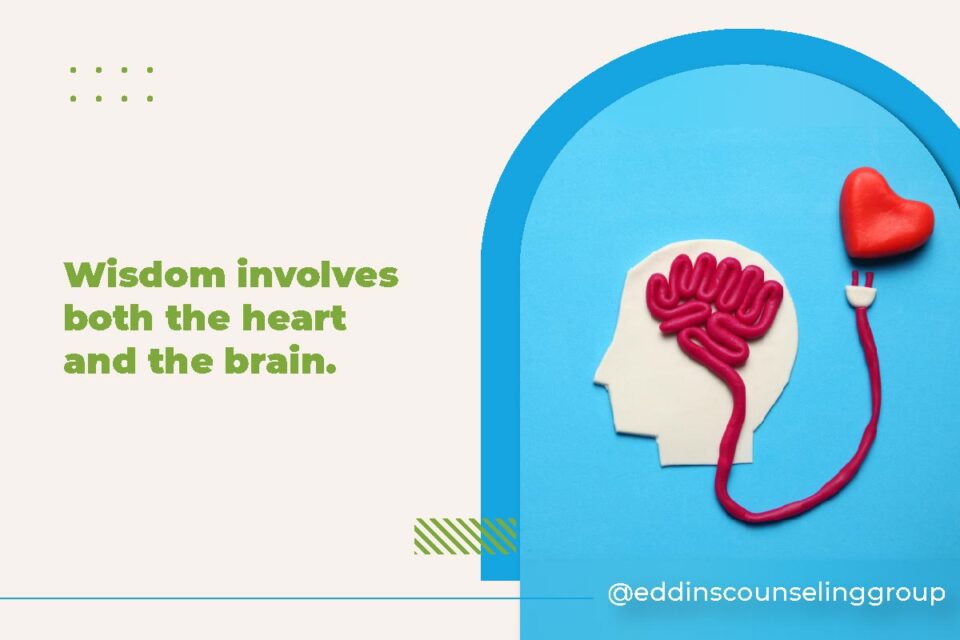
When we are mindful, we are able to grow in wisdom. We’re able to experience freedom by letting things go. Again, those are the attachments.
There’s a skill, and it’s really all about being a “Teflon pan”. So if you think about a Teflon pan, no matter what you put on it, it just slides off.
That’s what we should hope for in terms of letting things go. Just letting whatever comes in that moment slide right off of you and just staying centered and present and focusing on the here and now.
By doing so, we can really focus on love and compassion. That is just my favorite part of all of this because by engaging in mindfulness, we allow space in our lives for not only others but for ourselves.
I would argue that at least from what I see often is that to love yourself and to show self-compassion can be very difficult.
By being mindful, we are honoring our highest self. We’re honoring our mind, body, spirit, and soul, and we’re able to really truly give ourselves time and space to just be.
When we’re able to do that, I just think we’re able to show ourselves some self-compassion and we need a little bit more of that.

Practice, Practice, Practice
Mindfulness takes practice
- Identify, and focus on one thing.
- Bring your attention to the object of the focus.
- When your attention wanders – gently bring it back to focus without judgment.
All of this takes practice, practice, practice. Just three key points whenever you’re practicing these things in the car, you’re practicing them at home, you’re practicing them at work, and you’re practicing them when your kids are coming.
We are going to identify and focus on one thing at a time. Bring your attention to the object of focus.
And when your attention wanders, gently bring it back to focus without judgment. Do that over and over and over again until it just feels normal.
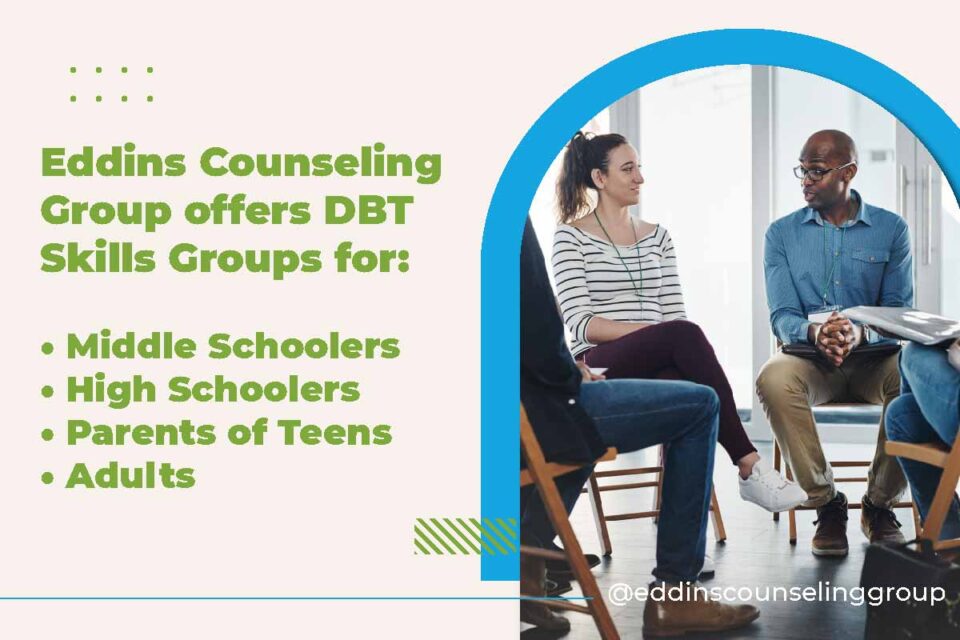
About the Facilitator
I am a DBT facilitator for middle schoolers here at Eddins Counseling Group. If any of you have middle schoolers that you think could benefit from DBT, which is something we use for people who experience big emotions.
And so it really helps with emotion regulation and really helps to connect to the wise mind, the middle path. Those are all things that we talk about in DBT.
So it’s not just mindfulness. There are a ton of other skills that come along with it that have a little bit more skill-based.
The idea is to just put tools in your tool belt to help you navigate interpersonal relationships and navigate life. I also specialize in trauma and family therapy, and I do have 12 years of experience working in the mental health field.
I’ve been working in a variety of different settings, including inpatient, residential, step-down, and PHP. And now I am so happy to be here at Eddins, and it’s just been great.
If you have or need any more information, you are welcome to call (832) 559-2622 or text (832) 699-5001. We would be happy to hear from you.
We also do facilitate DBT skills groups for high schoolers, adults, and DBT skills for parents of teens as well.
How does applying DBT differ between teenagers and senior citizens?
I would say there’s not a ton of difference. There’s been a lot of research on it, and so it’s pretty standard across the board. I think for teens, there’s just maybe a little bit less information when we’re giving information about why the skills are important.
So maybe if you could think about it just the same as any type of schooling that you’d have. Of course, the older you get, the more you have a little bit to work with in terms of dialog and things like that. But for the most part, it doesn’t differ.
DBT can be used for any age group.
Mindfulness Exercise: Showing Gratitude to Our Bodies
Plant your feet on the ground and sit in your chair upright. So give your body full attention. I want you to wiggle around and let yourself feel the sensations of your body.
Notice where you’re feeling any tension, where you’re feeling any stress, or anything because you want to give that part of your body a little bit more self-compassion.
We’re going to start from the top of our heads and we’re going to do a body scan. You’re scanning your whole body and you’re thinking about each part of your body, paying attention to each part, each piece of you.
- Today, I want us to say gratitude to the hair. So we’re saying gratitude to our hair for keeping our heads warm.
- I’m going to say thank you to our minds for all the vast and powerful ways it helps us throughout the day. Think about all of the things that we take for granted.
- About how our brains, these big brains just work for us and they do so many amazing things. And oftentimes we are so hard on ourselves.
Just say: “Thank you. Thank you for all that you do for me.”
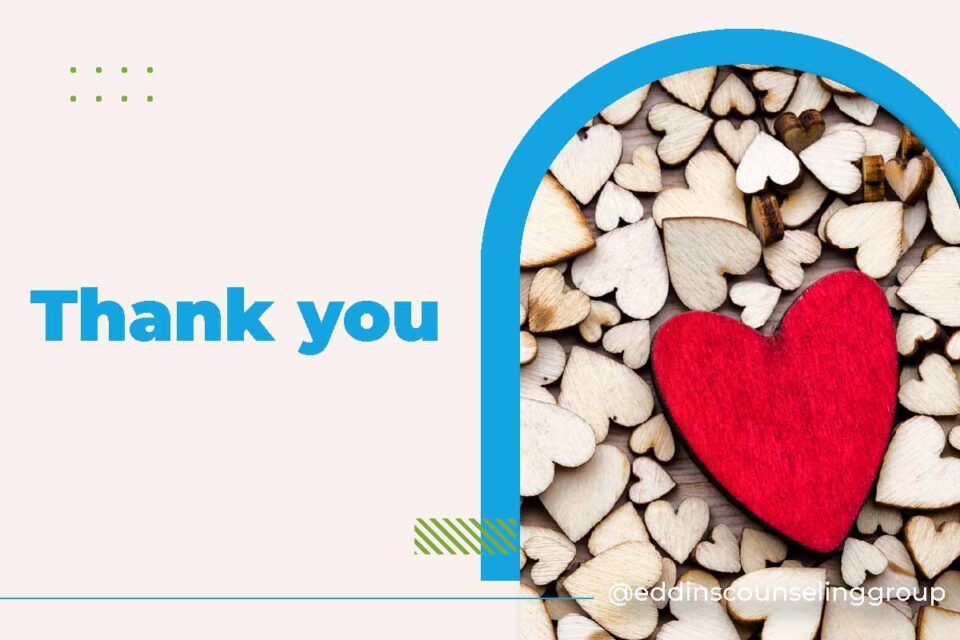
We can say thank you to our eyes for all the beautiful things we see.
- That can be your pet if your pet brings you a lot of joy.
- Perhaps it’s your family if they bring you joy.
- Maybe it’s the trees outside, or maybe it is flowers that you might see, or perhaps it is a piece of art that you love.
But all of these beautiful things that we see on a daily basis and we just tend to sometimes overlook. I’m going to say thank you for that.
Let us say thank you for our hearing. You guys were able to hear me today, so I would like to say thank you.
- Thank you for allowing us to hear wonderful music,
- hear the laughter of our favorite friend, and
- for all of those beautiful sounds that we hear on a daily basis that we often take for granted.
Let’s think about our noses and all of the wonderful smells we smell throughout the day. Say thank you for the gift of smell.
- Perhaps you get to smell chocolate, or
- maybe you get to smell eucalyptus. That’s one of my favorites.
- Maybe you get to smell your mom’s favorite dish that you love or something like that.
- Maybe it’s the smell of your home or your favorite blanket.
Let us say thank you for the ability to taste all the wonderful foods we get to have.
If you’re here in Houston, we have so many wonderful places to go eat and how lovely is it that we get to experience all these different tastes. Get to taste all kinds of different, spicy, sweet, sour, all of that goodness. Thank you for that.
If you’re holding any tension in your jaw or in your neck or shoulders, I really want you to just work it out, work it out. Work it out and say thank you just to your body as a whole. I like to say thank you for my arms because I’m a hugger and so I really love being able to just hug people.
I like to say thank you to my arms for that reason. But also, I love a fork. So thank you to my hands and say thank you for all the parts of you that you normally forget about and might neglect.
Let us say thank you to our hearts for leading us and guiding us, for the loving spaces that we hold, for our family and friends, and for each part of us that we get to share with others.
Thank you.

Let us just say thank you to all the other parts. We have our bellies that we get to fill with air and do our deep breathing with and also just for everything that does for us.
Thank you to our legs. I like to say thank you for my legs, for getting me all the places that I go on a daily basis. I even like to say thank you to my feet because that means that we can jump and run and do all the fun things that we used to do.
In this case, it’s really not just about your senses. It is really about getting connected.
Just touch each part of your body, especially you might feel like sometimes is not enough. And I just want you to say thank you. And then after you’re done and you’re fully showing gratitude to yourself, I just want you to say thank you to your being.
I would also like to say thank you to each of you for participating in that and for showing yourself some love and kindness today.
That is also another thing you can do on a daily basis. Now you can just take a couple of deep breaths. We did some good work together today.
If you need any more information, please feel free to reach out. We are so grateful for you today and we will have another wellness webinar in June, so be on the lookout for that. I think that is the end of this. Thank you all. Have a good night.
If you are interested in working with a DBT therapist in one of our locations – Houston Heights, Houston Montrose, or Sugar Land – get started today.
Grounding & Self Soothing
Get instant access to your free ebook.
Why You Feel This Way
Get instant access to your free ebook.


